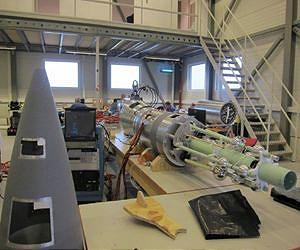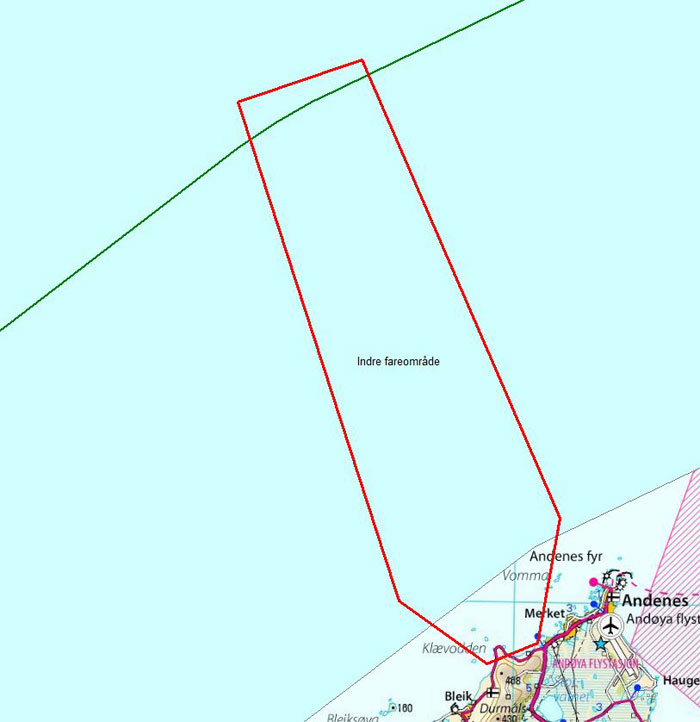.

The forward section of the experimental rocket, right, showing several of the scientific instruments that will measure the dusty plasma. Image courtesy UW Today and Todd Anderson.
.
US Navy to Launch Folding-Fin Ground Attack Rocket on Scientific Mission
US Naval Research Laboratory, in cooperation with the University of Washington and NASA, are set to launch folding-fin ground attack rocket from the Norwegian launch facility above the Arctic Circle to simultaneously create and observe "dusty plasmas" in Earth's outer atmosphere in order to understand how it disrupts radar and tracking systems.
The aim of the experiment, dubbed Charged Aerosol Release Experiment II (CAREII), is to reveal basic characteristics about a phenomenon, known as "dusty plasma", according to the website of the University of Washington (UW).
Dusty plasmas are complex, transient mixtures of ions, electrons and dust, which form and dissipate naturally when swift-moving objects move through the atmosphere - from a satellite launching into orbit to a meteorite burning up in the atmosphere.
Scientists say, they may be in the shape of spheres or rods or irregularly shaped pancakes. The phenomenon is thought to be a common source of interference for radar and radio communications and disruption of tracking systems.
"From a practical standpoint, normal atmospheric dynamics can get completely disrupted for a period of time," the website quotes UW professor of Earth and space sciences Robert Holzworth, who is working on this project along with his departmental colleague professor Michael McCarthy, as saying.
As dusty plasmas are very difficult to observe and characterize when they arise naturally, the mission of the CAREII is to use rocket engines to generate dusty plasma and simultaneously measure its characteristics using sensors on the rocket itself.
The mission is led and funded by the US Naval Research Laboratory, which provided the CRV7 rockets that will create the dusty plasma for the experiment and simultaneously measure its characteristics using sensors on the rocket itself.
CRV7 rocket, used for the experiment, is a folding-fin ground attack rocket, which remains one of the most powerful air-to-ground attack rockets to this day, and has slowly become the de facto standard for Western-aligned forces outside the US.
Researchers from the UW designed and constructed instruments in the rocket that will measure the dusty plasma's electrical field.
NASA provided launch and support services.
The experiment is set to go like this:
After a 50-foot-long rocket (15-meter-long) ascends over 160 miles (257 km) into the atmosphere, it will begin to fall back to Earth. At about 145 miles (233 km) above the Norwegian Sea, the forward section of the rocket, which contains most of the scientific instruments, will detach and aim its instruments toward the aft section.
The aft section will then simultaneously fire 37 small CRV7 rocket engines, creating a dusty plasma of known gas, ion and dust composition that will envelop the forward section of the rocket.
Probes and sensors in the forward section, including the UW's electric field instruments, will soak up information about the dusty plasma.
Radar and lidar stations on the ground and a nearby plane packed with cameras and sensors will also track and measure the artificial plasma.
"From start to finish, it will take 10 minutes," McCarthy said.
The CAREII rocket will launch from the Andoya Space Center, a rocket launch facility above the Arctic Circle near Andenes, Norway.
The mission has a two-week window starting on September 7 to launch the rocket. The team will wait for ideal visibility and atmospheric conditions to send the rocket up into the atmosphere.
"You want the dusty plasma illuminated but you want it dark on the ground," said Holzworth. "That's a narrow window that's typically longer at higher latitudes - about a half hour every day."
The CAREII mission follows up on the success of the original CARE experiment in 2009, which used a rocket launched from NASA's Wallops Flight Facility to create a dusty plasma in the skies above Virginia, which scientists observed using ground-based equipment.
-

ASC
Quelle: SD
4451 Views
